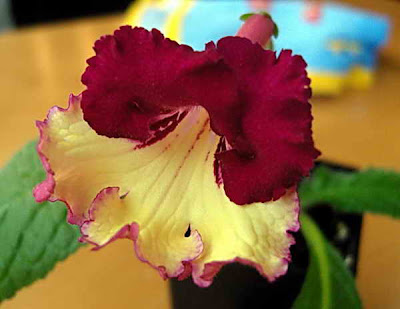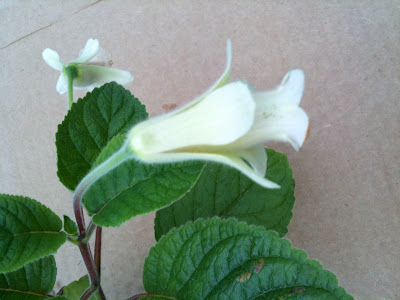 |
| Codonanthe devosiana --- Worth growing |
Content matters…
There have been three comments about the question: Can we make a species better?
Bringing them together here will keep the subject on track. If you have an opinion...
"It’s great to see that Gary (and other commercial growers) are thinking like this. Creating more grower- and market-friendly cultivars will surely lead to wider inroads of gesneriads into general horticulture!
The idea that a species can be “improved” is uncontroversial. It is founded in the observation that any wild population of a species includes considerable variation – flowers may vary in color, plants in height, leaves in shade of green or inclusion of other colors or patterns, and so on. In the natural world, these are the variants that under some circumstances may end up being the foundation of new species through the process of natural selection.
In the cultivated world, though, often we are seeing only a very limited sample of the variation that occurs in the wild. In some cases, the plants we are growing descend from a single collected ancestor. The assumption gets made that the “species” is very limited, and that progeny will all be pretty much identical. And this is true, given the very limited gene pool for many of the species we are growing.
This is why it is so very important to recognize the importance of sampling as broad a range of the true species as possible. Whenever we can find a new collection of, say, Sinningia pusilla, it’s important to try to bring those genes into cultivation so that we can refresh our existing collection with new vigor and potentially new characteristics.
In some cases, this happens through identification of variant populations of species. For instance, we now see many different forms of the wild species Sinningia speciosa in cultivation. Modern botanical conviction is that these variants are simply that – variants of a single species. In past days, the conviction might have been that they represent separate species even if they can successfully interbreed. In any case, it is refreshing to see such focus on species variants.
It’s important, though, to recognize that important variations might be much more subtle than those between dramatically different forms of S. speciosa. Creation of new more cultivation-friendly forms of Codonanthe devosiana is going to be easier if we have access to significant genetic variation within the species, even if this variation is relatively minor. I suspect that the cultivated forms may not represent much of that diversity; it may be that real success in this endeavor will await collection of additional forms of the species from its Brazilian home."
Ron
Copied from Gesneriphiles, 17 Dec 2012
"Well I was going to write a response to this piece when I saw it in Mel Grice’s Gleanings last week, but like many other projects it got put to the side. It might have been tabled permanently but for the news this morning that newplantsandflowers.com had picked it up and run with it. On the one hand that’s a great piece of news for the gesneriad world, as it’s always good to get some free publicity on our favorite plants. On the other hand, it’s a little bit disconcerting because to my perhaps somewhat warped way of thinking, Gary’s question is answered quite simply. The answer is “No.”
Okay, to elaborate on this I think that the question is not an accurate question.I recognize that to some this may seem to be picking nits, as the saying goes. I certainly got that sort of response when I started to complain about Michael Pollan’s hit book “The Botany of Desire,” which even got picked up by PBS and made into a four part documentary – I’ve never been more unimpressed with public television in my life. But I suppose that’s another story.
The difficulty is that while I understand Gary’s interest in “improving” the species, as soon as he starts manipulating for particular traits which he thinks would be more desirable, he is working with this human selecting process, which is why we call the results “selections” and “cultivars.” The species complex which has stood the test of time with sometimes subtle and in other cases impressive variability, while admittedly still in the evolutionary process if we can step back and look at it over hundreds or thousands of generations, has worked for this species in the wild. What does that mean? It means that the species with those variations just referenced, has survived.
Larger flowers? More pink in the corolla? Quicker growth from seed to blooming plant? They may indeed all be occasionally out there in the wild, and if Gary starts sowing and growing lots and lots of these plants, and with each generation just picks his favorites and then sees with subsequent generations if those traits carry through, and then picks them again if they do, etc. etc., he may well come up with a plant that he likes better, maybe one that everyone likes better. And if with all his selfing crosses he stays within the scientific understanding of the species definition, he will perhaps technically not be doing any hybridizing. However, from the get-go he is working with selections and cultivars of this particular species, which is to a nit-picker like me entirely different from “improving the species.” It may be picky here, but if not here, the next thing you know we’ll be talking, like Michael Pollan did to the delight of millions, plants with some purpose manipulating us so that their range and in some cases specific qualities can improve over time. Picky, I know – but you get misinterpreted and in the blink of an eye the turn of a phrase changes from accurate science to good storytelling, and for those that don’t see the shift the good storytelling gets better and better and is still accurate science.
Well I’ve said enough to start this off (?) Perhaps this will start a lively discussion – or perhaps not. Good Growing – and Gary – good luck with your selection process."
Jonathan
Copied from Gesneriphiles 17 Dec 2012
Cool project. I'd be interested in helping out. Have you thought of mutagenesis as a way of speeding things up?carol.gates@earthlink.net
Copied from comments, 17 Dec 2012




.jpg)


















